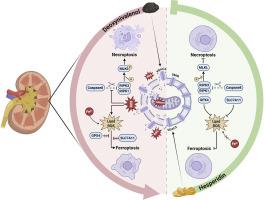橙皮苷通过调节VDAC3减轻脱氧雪腐酚诱导的肾铁下垂和坏死下垂。
IF 8.3
1区 医学
Q1 CHEMISTRY, MEDICINAL
引用次数: 0
摘要
脱氧雪腐镰刀菌醇(DON)是一种广泛存在于真菌产生的谷物和饲料中的次级代谢物,对全球经济和食品安全构成重大威胁。DON通过生物链富集对农业动物健康构成严重威胁。橙皮苷(HDN)以其广泛的来源和卓越的抗氧化能力而闻名。尽管HDN的许多药理活性已经被了解,但HDN减轻DON暴露引起的肾损害的潜在改善机制仍不清楚。目的:探讨HDN抗don肾毒性的作用机制。方法:我们首先建立体外DON暴露模型,并给药2次HDN给药TCMK-1。采用蛋白质组学、透射电镜(TEM)、荧光探针、原子力显微镜(AFM)、CETSA等技术研究HDN是否能减轻don引起的肾毒性及其具体机制。随后,用C57BL/6小鼠进行体内验证。结果:HDN可减轻don诱导的TCMK-1铁下垂和坏死性下垂。机制上,HDN通过靶向电压依赖性阴离子通道3 (VDAC3),恢复线粒体完整性,降低DON引起的TCMK-1上的mtROS积累。此外,HDN给药干预后,don引起的小鼠肾损伤得到缓解。结论:HDN是一种VDAC3靶样化学物质,可降低DON暴露引起的肾对铁下垂和坏死性下垂的易变性。我们的研究为don引起的肾损伤提供了一种创新的治疗方法。本文章由计算机程序翻译,如有差异,请以英文原文为准。

Hesperidin mitigates deoxynivalenol-induced renal ferroptosis and necroptosis by regulating VDAC3
Background
Deoxynivalenol (DON), a secondary metabolite widespread in cereals and feeds generated by fungi, poses a major threat to the global economy and food safety. DON constituted a serious risk to the health of agricultural animals through biological chain enrichment. Hesperidin (HDN) is renowned for its broad spectrum of sources and exceptional antioxidant capability. Despite the fact that numerous pharmacological activities of HDN have been understood, the underlying ameliorative mechanisms of HDN in reducing kidney damage caused by DON exposure remain unclear.
Purpose
This study aimed to investigate mechanism of HDN against DON-induced nephrotoxicity.
Methods
We initially established an in vitro DON exposure model and administered two doses of HDN to TCMK-1. Proteomics, TEM, fluorescent probes, AFM, CETSA, and other techniques were employed to investigate whether HDN could mitigate DON-induced nephrotoxicity and specific mechanisms. Subsequently, in vivo validation was performed using C57BL/6 mice.
Results
We found that HDN could mitigate DON-induced TCMK-1 ferroptosis and necroptosis. Mechanistically, by targeting voltage-dependent anion channel 3 (VDAC3), HDN restored mitochondrial integrity and lowered mtROS buildup on TCMK-1 brought on by DON. In addition, DON-induced renal injury in mice was alleviated after HDN dosing intervention.
Conclusions
HDN, a VDAC3 target-like chemical, might reduce the vulnerability of the kidney to ferroptosis and necroptosis brought on by DON exposure. Our study offers an innovative therapeutic approach with regard to DON-induced kidney damage.
求助全文
通过发布文献求助,成功后即可免费获取论文全文。
去求助
来源期刊

Phytomedicine
医学-药学
CiteScore
10.30
自引率
5.10%
发文量
670
审稿时长
91 days
期刊介绍:
Phytomedicine is a therapy-oriented journal that publishes innovative studies on the efficacy, safety, quality, and mechanisms of action of specified plant extracts, phytopharmaceuticals, and their isolated constituents. This includes clinical, pharmacological, pharmacokinetic, and toxicological studies of herbal medicinal products, preparations, and purified compounds with defined and consistent quality, ensuring reproducible pharmacological activity. Founded in 1994, Phytomedicine aims to focus and stimulate research in this field and establish internationally accepted scientific standards for pharmacological studies, proof of clinical efficacy, and safety of phytomedicines.
 求助内容:
求助内容: 应助结果提醒方式:
应助结果提醒方式:


